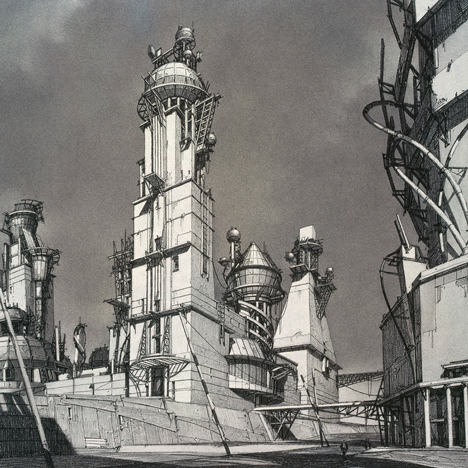Berlin's Tchoban Foundation museum for architectural drawing is showing an exhibition of futuristic sketches by late experimental architect Lebbeus Woods.
The exhibition – titled Lebbeus Woods ON-line – brings together a collection of Woods' early work from the 1980s and 1990s at the Tchoban Foundation, which opened last year and features architectural sketches etched across its concrete facade.
Woods, who died in 2012, was revered for his depictions of experimental and deconstructed architecture, which continue to serve as inspiration for students, architects and academics.
Curated by his friend and partner Christoph A Kumpusch, the set of drawings in this exhibition show the beginnings of his studies into dystopian cityscapes and science-fiction landscapes.
"The focus is on the remarkable representations of architectonic and urban worlds that Woods created at the beginning of his career," said a statement from the museum.
It includes the series 4 Cities & Beyond (1982–83), in which traditional buildings are replaced with towering abstract shapes to create scenes of futuristic skylines.
These are shown alongside his later A City (1987) and Centricity (1987–88) works, which further Woods' ideas and include structures that integrate detailed machine-like architectural features and infrastructure.
Region M (1984) shows a crumbling metropolis where, in one image, its inhabitants appear to be discussing the future of their home.
A subterranean cityscape is imagined in Underground Berlin (1988), where structures breach the surface and are depicted against the German capital's existing skyline.
The architectural and urban scenes are accompanied by his Geomagnetic Flying Machines (1988), a series of sketches showing metal shells with exposed frames and wires hovering in space.
Along with Woods' designs for a Meta-Institute (1994–95), these projects are being exhibited together for the first time.
"By highlighting various aspects of his signature style, the exhibition honours Woods' dedication to consider drawing as a highly effective and evocative instrument for imparting the teachings and ideas of architecture," said the museum.
Woods created the artworks in a range of media including pencil, coloured pencil and ink, drawn on paper, tracing paper and board.
"Colour, contrast and shading serve towards the drawings' clarity and atmosphere, which – being simultaneously powerful and shatterable in their appearance – have been infused with the artists' warmth and humanity," said the museum. "They also communicate the vision, that drawings can express things that cannot be put into words."
Woods trained as an architect at the University of Illinois and worked under Eero Saarinen, before leaving practice to focus on theory and experimentation.
He also co-founded the Research Institute for Experimental Architecture, where he developed a number of conceptual projects aimed at finding architectural answers to contemporary world problems.
Lebbeus Woods ON-line runs until 3 October. Images courtesy of Estate of Lebbeus Woods.

